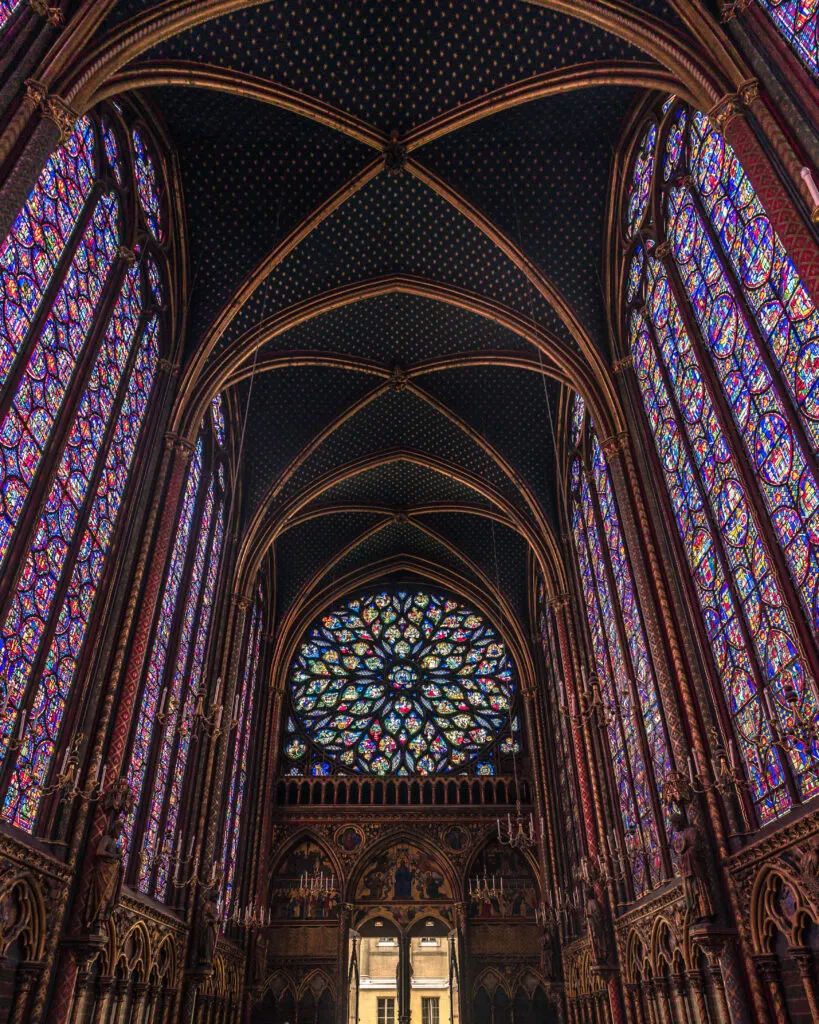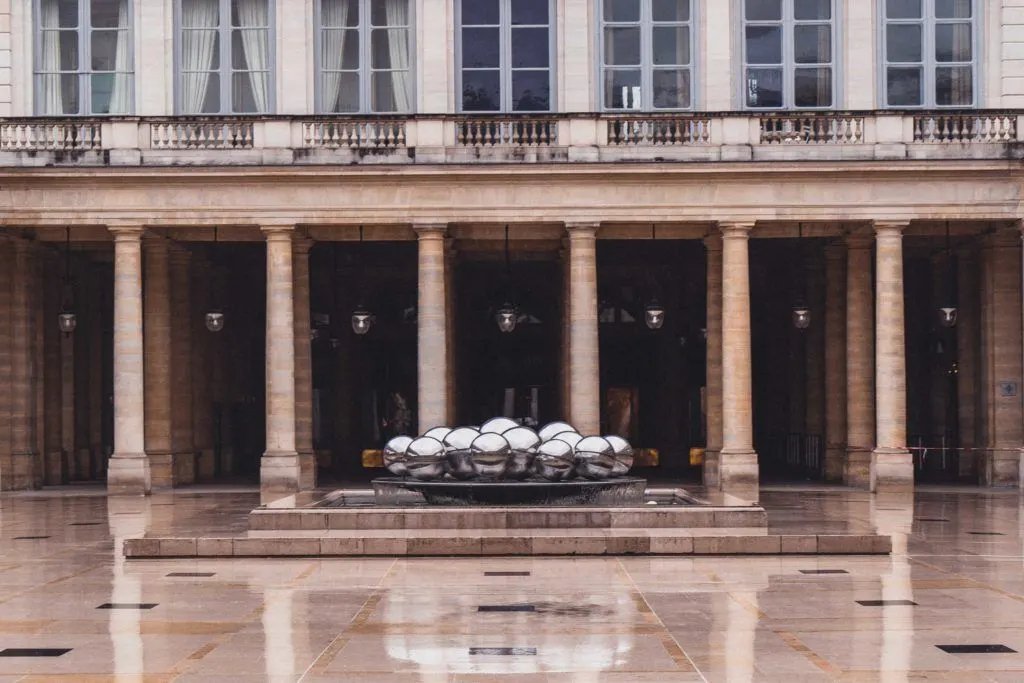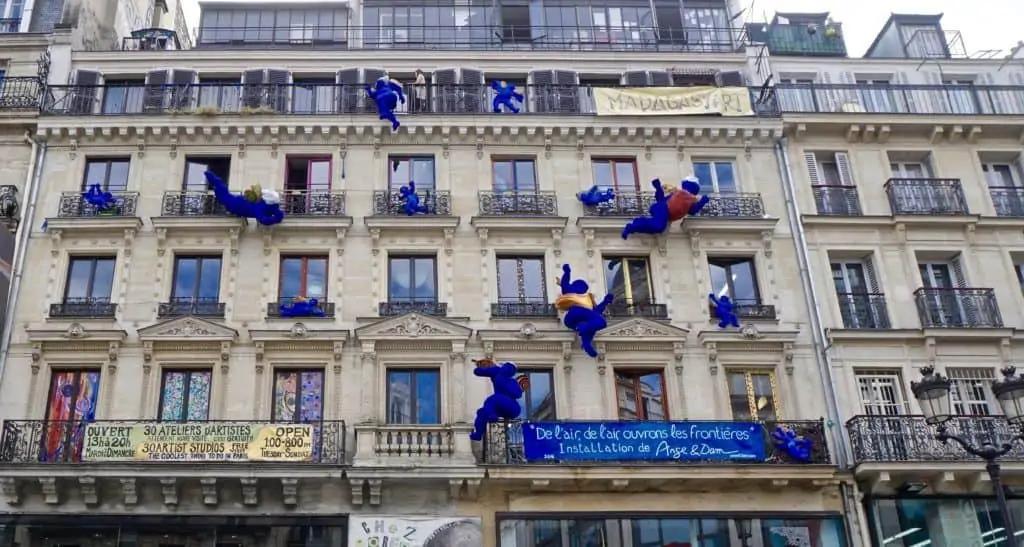Last Updated on 11th May 2024 by Sophie Nadeau
Home to magnificent palaces, gigantic museums and vibrant gardens, the 1st arrondissement is the cultural core and very heart of historic Paris. Here’s your neighbourhood guide to the 1st arrondissement of Paris (1er or le premier Arrondissement in French), including top travel tips and things to do!

Contents
Where is the 1st arrondissement?
The first arrondissement is known in French as le premier arrondissement and is one of the 20 arrondissements of Paris. With a population of around 16,000 residents, it is the least populated of the city’s arrondissements and also one of the smallest by area.
Situated on the right bank of the River Seine, this area also includes the west end of Île de la Cité, the tiny island of the Seine which is home to Sainte Chapelle and Notre Dame Cathedral. The 1st arrondissement is thought to be one of the oldest inhabited areas of Paris and parts of it were even inhabited by the Romans and their predecessors.

What is the 1st arrondissement known for?
The 1st arrondissement is famed for its abundance of historic and cultural attractions, shopping arcades, hidden gardens and public parks. Although it’s one of the smallest areas in Paris, there’s a lot to see and fall in love with in this arrondissement!
If you are wondering how to spend a rainy day in Paris, then look no further than the 1st arrondissement as there are plenty of indoor and covered attractions scattered around the area.


Best things to do in the 1st arrondissement
Due to its central location, it should come as no surprise that the 1er arrondissement is chock-full of things to do! From free to visit gardens to world-leading museums, this is one area you won’t want to miss during your French capital trip.
Louvre Museum
With its status as the largest art museum in the world, the Louvre is one of Paris’ top attractions. Home to the likes of the Mona Lisa, Venus de Milo, and the Winged Victory of Samothrace, as well as the iconic glittering central pyramid at its entrance.
Originally built in 1190 as Château du Louvre, it was once a defensive fortress. By 1793 it was founded and transformed into a cultural space, and in 1989 the iconic glass pyramid was built outside to celebrate the bicentenary year of the French Revolution.
Today, the Louvre stands as a popular institution. Welcoming an estimated 30,000 visitors per day it’s one of the most visited attractions in all of Europe and is the number one attraction on many first time to Paris visitors’ bucket lists.
The average time spent here is 3 hours, but to be honest if you’re a history buff you could easily spend a whole day here and still not be able to see everything! If you plan to visit, I highly recommend making a plan of what you want to see beforehand to make things simpler. For more tips on what to know before you visit the Louvre, read our guide here.
Also! Did you know that on the first Sunday of each month between 6 PM – 9:45 PM, and all day on Bastille Day (July 14th) it’s free to visit the Louvre!

Cour Carrée
Translated as ‘square court’ this is one of the main original courtyards of the Louvre. Construction started between 1190 and 1215. Today, as you stroll through you can marvel at the magnificent Renaissance architecture of French classicism. Unlike the interior of the Louvre, this area is completely free to visit and wander around.

Jardin des Tuileries
This green expanse is situated between the Louvre and the Place de la Concorde, a delightful garden so-called because it was once the site of a tile factory.
Jardin des Tuileries was originally created by Catherine de’ Medici in 1564 to serve as a garden for the now-demolished Tuileries Palace. Just over a century later, in 1667, the garden was opened to the public. Following the French Revolution in the 18th-century, it was officially designated as a public park and free to visit for all Parisians.
This is the oldest and biggest Parisian garden! Named a World Heritage site by UNESCO for its outstanding beauty, situated within the park you’ll find a number of things including:
- Orangerie – hands down one of the best museum in Paris, this is where you’ll find Monet’s famed waterlily paintings
- Arc de Triomphe du Carrousel (currently undergoing intensive renovations)
- Jardin des Tuileries funfair – every year from the beginning of July till the end of August.
It’s important to note: Free to visit, but like most parks in Paris, Jardin des Tuileries has an opening and closing time, which typically mirrors the sunrise and sunset times across the year.
Also, the grass is off limits (you’ll understand when you see how pristine it’s kept)! However, picnics are encouraged and there are several benches as well as chairs which you are welcome to move around and sit on.

Musée de l’Orangerie
Nestled in between rows of Plane trees in the heart of the Jardin des Tuileries, the Musée de l’Orangerie is, like its name suggests, housed in a former orangery.
Constructed in the 1850s, it was originally built to house the orange trees of the Tuileries garden. During the Third Republic, the structure was then used for a variety of things, including as an examination room, and as a place where soldiers could stay.
Today, the museum is home to Monet’s iconic waterlilies (which were created specifically for the space and depict the waterlilies of his house in Giverny) as well as other treasured impressionist and post-impressionist paintings, from the likes of Van Gogh, Picasso, Renoir, and Rousseau.

Sainte-Chapelle
Sainte-Chapelle contains some of the oldest and extensive pieces of stained glass in the World. It was originally built to house Louis IX’s collection of religious relics, including the Crown of Thorns, and the ecclesiastical building can be found on Île de la Cité.
‘Sainte Chapelle’ translates into English roughly as ‘Holy Chapel’. Construction of the building began sometime around 1242, though exact dates are uncertain. The ecclesiastical building was finally consecrated upon its completion in 1248.
What many people don’t realise is that there are actually two parts to Sainte-Chapelle; the lower chapel and the upper chapel. On your visit I highly recommend opting to purchase an audio guide, this will give you an extensive detailed history on Saint-Chapelle and its significance in Paris.
Top tip: If you’re looking to visit this magnificent example of medieval Parisian architecture for yourself, be sure to visit in the early morning, when the chapel first opens. This way, you’ll have to queue for the least possible time as the crowds do tend to pile up later on in the day. Sainte-Chapelle welcomes over 900,000 visitors per year.

Palais-Royal
Situated across the street from the Louvre, the Palais-Royal complex today is “Paris in a nutshell”, home to cosy French cafés, history, art, architecture, shops and gardens. That being said, Palais Royal has seen centuries worth of history unfold and played a prolonged role in the history of Paris ever since its inception in 1629, by the acclaimed architect, Jacques Lemercier.
Once the personal residence of Cardinal Richelieu, it was originally named Palais Cardinal. Upon his death, the building, courtyards and accompanying gardens were passed into the king’s ownership. From this point onwards, the palace was renamed ‘Palais Royal’.
In the 1780s, the Palace and gardens were greatly redeveloped. Additional columns and passages were added to the Gardens, which can still be seen today. And, it was at this point that the Gardens of Palais Royal were opened to the public.
Arcades (consisting of 145 boutiques) were added to the gardens. Various shops and cafés were added, including Paris’ first restaurant, the Grand Véfour, which is now one of the most exclusive addresses in the city (it can take weeks or even months to get a booking).
Although the palace building itself is closed to the public, Palais Royal Garden is a welcome respite from the crowds of Paris. It’s free to visit and typically open during daylight hours. Making for the perfect place to catch up with friends, grab a coffee and soak up the history of this gorgeous space!

Colonnes de Buren/Les Deux Plateaux
Situated within Palais-Royal, and arguably one of the things that make it so special, and sets it apart from other public spaces in the city are the Colonnes de Buren.
Created by French artist Daniel Buren in 1985, the columns actually stand on what was once a parking lot, with the aim to conceal a ventilation shaft. The artwork can be found on the inner courtyard (Cour d’Honneur) of Palais-Royal.
Initially causing outcry at the time, this art installation sparked a debate as to whether or not it was acceptable to impose a piece of modern art on such an old and historic site. They have since become an iconic art work in the city and it is considered good luck to toss coins into the pools of water that form at the base of the columns.
Free to visit, they are a popular spot for people to hop along the small columns and snap a photo or two within the historic Palais-Royal complex.

Palais de Justice
Located on the Île de la Cité right beside Sainte-Chapelle is the judicial centre and courthouse of Paris, Palais de Justice. Standing as one of the most prestigious official buildings in the city, it is also one of the oldest and dates back to the 10th century, built on top of the site of a former Roman palace.
Even if the complicated history of French law doesn’t interest you, the building itself is fascinating. Adorned with intricately carved walls and gigantic marble floored corridors, it certainly offers a unique experience while wandering through!
The Palais de Justice is open to the public and free to enter, but no photographs are allowed.

Explore the covered passageway, Galerie Véro-Dodat
Situated in the 1st arrondissement of the city, Galerie Veró-Dodat is close to the Louvre and is an antique lover’s haven in the heart of Paris. All tile flooring, stained glass ceiling, and vintage stores, the covered passage offers refuge from the elements and would most certainly have been a welcome reprieve from the mud of the streets during the 19th-century when the passage was originally installed…
Built in 1826, Galerie Veró-Dodat was one of the first covered passages to receive gas lighting, an incredibly modern technology at the time. In 1997, the gallery was renovated, restoring Galerie Vero-Dodat to its Neo-Classical heyday.
All black and white tiling and moulded ceilings, the passage is best-known for its many antique stores. Today you can walk down and window shop at the treasures that are within, leaving you feeling as though you’ve stepped back in time to 19th century Paris!


59 rue de Rivoli
59 Rue de Rivoli is an unassuming six-storey, Haussmann-style building situated in the very heart of the 1st arrondissement of Paris. A cross between a gallery, museum and a working studio, you don’t just see a selection of the artist’s best works, but also their works in progress (with a possibility of meeting the artist too!)
In 1999, a trio of artists managed to break down the doors of this abandoned building and began cleaning the place up. They then started exhibiting their works to members of the public and 59 rue de Rivoli, home to artists, was born.
In 2000, the French state tried to evict the artists. However, luckily this failed due to the combination of a good lawyer and growing attention from the media. ‘Squart’- a mixture of squat and art- was the name given to this unique atelier that was rapidly growing in popularity.
Today, there are up to 30 artists in residence at any given time and every weekend, there are concerts. No two visits to 59 Rue de Rivoli is ever the same!
One of the more unique places to visit while exploring Paris, the ateliers are free to visit (although there are donation points dotted around the building) Lots of the works are available to purchase. And all of the works on display are incredibly interesting. Open from 11:00 AM – 20:00 PM daily, closed Monday’s.

Fontaine des Innocents
Quite literally translated into English as the ‘Fountain of the Innocents,’ this Parisian water feature was created during the 16th-century and is the oldest public fountain in Paris.
The fountain was built as a memorial to the city’s lost cemetery, it stands on the site which was once home to Paris’ largest cemetery. Mass burials regularly took place inside the graveyard’s walls, and just one month during the Plague saw thousands of burials.
Fontaine des Innocents was designed by Pierre Lescot (who worked on the Louvre), and is said to have been inspired by the Nymphaeum in Rome, while the sculptor Jean Goujon (who also worked on the Louvre) truly brought the Renaissance piece to life.
In fact, the fountain was originally called the ‘Fountain of Nymphs’, the structure is intricately carved and covered in foliate patterns and mythical sea creature designs, as well as Nymphs.
Whereas other monuments were lost in time, the fountain was well preserved thanks to the promise of the young artists behind its design. Of course, over time, the monument has been modified several times and transferred into several different places.
Today, the fountain is free to visit and easily accessible! Though there are no benches in the square where the fountain is situated, people often sit on the low walls of the fountain instead.

Eat at Trantranzai
Hands down one of my favourite places to go for a quick bite to eat in Paris is Trantranzai (as you can see from the photos below, I keep going back!) There are three scattered across the city, one of which is in the 1st arrondissement on Rue St Denis.
Quick, efficient, and, most importantly, tasty! Trantranzai is a Chinese restaurant that specialise in noodles. Their menu is pretty small, but they offer vegan and vegetarian friendly dishes. When ordering noodles you’ll be asked what spice level you prefer between 1 to 6 (with 6 being the spiciest). However, after having been to the restaurant several times I have noticed that the the spice levels can change depending on the chef.



Where to stay in the 1st arrondissement
Located right in the heart of some of the biggest cultural and historical attractions of Paris, the 1st arrondissement makes for a great place in the city to base yourself; especially if you have little time and want to cram as much into your itinerary as possible.
That being said, because of its prime location you may find that places to stay are on the more costly side than other options in the city. Here are a few top suggestions of where to stay, based on web-reviews:
Hotel Ducs de Bourgogne – This refined hotel is set within a beautiful 18th century building and is just an 8 minute walk from the Louvre museum and 15 by foot from the Cathédrale Notre-Dame. Amenities include: free Wifi, gym, lounge area and a buffet breakfast is offered for a surcharge. Check prices and availability here.
Hôtel de la Place du Louvre – Esprit de France – Mid-market, this 4-star hotel is a 7 minute walk from the Louvre and a 5 minute walk from Pont Neuf metro station. Spacious and airy rooms, there’s also a free breakfast option available. Check prices and availability here.
Le Burgundy Paris – If you’re up for splashing the cash, why not opt for this luxury 5-star fashionable boutique hotel! Situated a 14-minute walk from the Musée du Louvre. The chic rooms offer free Wi-Fi, there’s a restaurant, spa area and indoor pool with a fountain to enjoy. Check prices and availability here.
Enjoyed reading about the best things to do in the 1st arrondissement, Paris? Pin this article now, read it again later:

Charlotte is a photographer, cat lover and an avid knitter. When she’s not curled up on the sofa with her newest knitting project (and Rico her cat!) you can find her out and about on long walks. Currently living in the magical city of Edinburgh, she looks forward to travelling and seeing more of the world!
